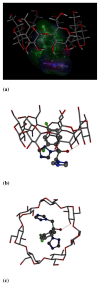NMR and molecular modelling studies on the interaction of fluconazole with beta-cyclodextrin
- PMID: 19664263
- PMCID: PMC2739844
- DOI: 10.1186/1752-153X-3-9
NMR and molecular modelling studies on the interaction of fluconazole with beta-cyclodextrin
Abstract
Background: Fluconazole (FLZ) is a synthetic, bistriazole antifungal agent, effective in treating superficial and systemic infections caused by Candida species. Major challenges in formulating this drug for clinical applications include solubility enhancement and improving stability in biological systems. Cyclodextrins (CDs) are chiral, truncated cone shaped macrocyles, and can easily encapsulate fluconazole inside their hydrophobic cavity. NMR spectroscopy has been recognized as an important tool for the interaction study of cyclodextrin and pharmaceutical compounds in solution state.
Results: Inclusion complex of fluconazole with beta-cyclodextrins (beta-CD) were investigated by applying NMR and molecular modelling methods. The 1:1 stoichiometry of FLZ:beta-CD complex was determined by continuous variation (Job's plot) method and the overall association constant was determined by using Scott's method. The association constant was determined to be 68.7 M-1 which is consistent with efficient FLZ:beta-CD complexation. The shielding of cavity protons of beta-CD and deshielding of aromatic protons of FLZ in various 1H-NMR experiments show complexation between beta-CD and FLZ. Based on spectral data obtained from 2D ROESY, a reasonable geometry for the complex could be proposed implicating the insertion of the m-difluorophenyl ring of FLZ into the wide end of the torus cavity of beta-CD. Molecular modelling studies were conducted to further interpret the NMR data. Indeed the best docked complex in terms of binding free energy supports the model proposed from NMR experiments and the m-difluorophenyl ring of FLZ is observed to enter into the torus cavity of beta-CD from the wider end.
Conclusion: Various NMR spectroscopic studies of FLZ in the presence of beta-CD in D2O at room temperature confirmed the formation of a 1:1 (FLZ:beta-CD) inclusion complex in which m-difluorophenyl ring acts as guest. The induced shift changes as well as splitting of most of the signals of FLZ in the presence of beta-CD suggest some chiral differentiation of guest by beta-CD.
Figures








Similar articles
-
Molecular recognition of flunarizine dihydrochloride and β-cyclodextrin inclusion complex by NMR and computational approaches.Chem Cent J. 2018 Mar 28;12(1):33. doi: 10.1186/s13065-018-0395-4. Chem Cent J. 2018. PMID: 29589200 Free PMC article.
-
Complexation study of midazolam hydrochloride with beta-cyclodextrin: NMR spectroscopic study in solution.Magn Reson Chem. 2008 Jul;46(7):676-9. doi: 10.1002/mrc.2231. Magn Reson Chem. 2008. PMID: 18381674
-
Multimodal molecular encapsulation of nicardipine hydrochloride by beta-cyclodextrin, hydroxypropyl-beta-cyclodextrin and triacetyl-beta-cyclodextrin in solution. Structural studies by 1H NMR and ROESY experiments.Eur J Pharm Sci. 2003 Apr;18(5):285-96. doi: 10.1016/s0928-0987(03)00025-3. Eur J Pharm Sci. 2003. PMID: 12694880
-
Molecular modelling and 1H-NMR: ultimate tools for the investigation of tolbutamide: beta-cyclodextrin and tolbutamide: hydroxypropyl-beta-cyclodextrin complexes.Chem Pharm Bull (Tokyo). 2001 Oct;49(10):1251-6. doi: 10.1248/cpb.49.1251. Chem Pharm Bull (Tokyo). 2001. PMID: 11605649
-
NMR characterization of the host-guest inclusion complex between beta-cyclodextrin and doxepin.Magn Reson Chem. 2008 Sep;46(9):838-45. doi: 10.1002/mrc.2267. Magn Reson Chem. 2008. PMID: 18615634
Cited by
-
Achievement of the Selectivity of Cytotoxic Agents against Cancer Cells by Creation of Combined Formulation with Terpenoid Adjuvants as Prospects to Overcome Multidrug Resistance.Int J Mol Sci. 2023 Apr 28;24(9):8023. doi: 10.3390/ijms24098023. Int J Mol Sci. 2023. PMID: 37175727 Free PMC article.
-
Molecular recognition of flunarizine dihydrochloride and β-cyclodextrin inclusion complex by NMR and computational approaches.Chem Cent J. 2018 Mar 28;12(1):33. doi: 10.1186/s13065-018-0395-4. Chem Cent J. 2018. PMID: 29589200 Free PMC article.
-
Rapid Ion Mobility Separations of Bile Acid Isomers Using Cyclodextrin Adducts and Structures for Lossless Ion Manipulations.Anal Chem. 2018 Sep 18;90(18):11086-11091. doi: 10.1021/acs.analchem.8b02990. Epub 2018 Aug 24. Anal Chem. 2018. PMID: 30102518 Free PMC article.
-
Insight into the Inclusion Complexation of Fluconazole with Sulfonatocalix[4]naphthalene in Aqueous Solution, Solid-State, and Its Antimycotic Activity.Molecules. 2022 Jul 11;27(14):4425. doi: 10.3390/molecules27144425. Molecules. 2022. PMID: 35889298 Free PMC article.
-
Ionization states, cellular toxicity and molecular modeling studies of midazolam complexed with trimethyl-β-cyclodextrin.Molecules. 2014 Oct 21;19(10):16861-76. doi: 10.3390/molecules191016861. Molecules. 2014. PMID: 25338177 Free PMC article.
References
-
- Meunier F, Aoun M, Gerard M. Therapy for oropharyngeal candidiasis in the immunocompromised host: a randomized double-blind study of fluconazole vs. ketoconazole. Rev Infect Dis. 1990;12:S364–S368. - PubMed
-
- MacMillan ML, Goodman JL, DeFor TE, Weisdorf DJ. Fluconazole to prevent yeast infections in bone marrow transplantation patients: a randomized trial of high versus reduced dose, and determination of the value of maintenance therapy. Am J Med. 2002;112:369–379. doi: 10.1016/S0002-9343(01)01127-5. - DOI - PubMed
-
- Dodziuk H. Cyclodextrins and Their Complexes. Chemistry, Analytical Methods, Applications. Wiley-VCH: London; 2006. - PubMed
LinkOut - more resources
Full Text Sources

